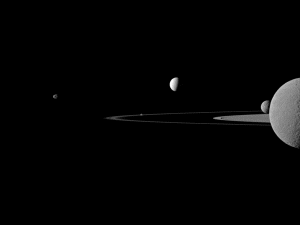Saturn's 'Death Star' moon has a hidden secret - a subsurface ocean
 Send a link to a friend
Send a link to a friend
 [February 08, 2024]
By Will Dunham [February 08, 2024]
By Will Dunham
WASHINGTON (Reuters) - Saturn's moon Mimas is known for its uncanny
resemblance to the dreaded Death Star in the original "Star Wars" movie.
But it has another intriguing distinction as well, according to
researchers - a subsurface ocean hidden under its icy and crater-scarred
outer shell.
Astronomers said on Wednesday that data obtained by NASA's Cassini
spacecraft on the rotational motion and orbit of Mimas confirm the
presence of an ocean of liquid water beneath an ice layer 12-19 miles
(20-30 km) thick. This ocean, they said, appears to have formed
recently, in cosmic terms - less than 25 million years ago and likely
between 5 and 15 million years ago.
The findings make Mimas a compelling site for exploration into the
conditions that could lead to the formation of life, considering Earth's
first living organisms arose in our planet's primordial seas billions of
years ago.
"At first glance, it is the most unlikely place in the solar system to
look for liquid water," said Observatoire de Paris astronomer Valery
Lainey, lead author of the study published in the journal Nature. "It
looks old and inactive - a huge amount of craters. Nothing betrays the
ocean existence, at the moment."
Mimas becomes the smallest of five moons in our solar system with
compelling evidence of subsurface oceans, alongside Saturn's Enceladus
and Titan, and Jupiter's Europa and Ganymede, Lainey said. There also
are suspicions of subsurface oceans on a few other moons, including
Jupiter's Callisto.
Cassini finished 13 years of studying Saturn and its moons in 2017 with
a death plunge into the huge ringed planet's atmosphere. Cassini's
observations of the icy surface of Mimas did not spot any deformations
suggestive of an ocean below. But the researchers determined that
certain aspects of its orbit could be explained only by the presence of
an internal ocean, not a solid interior.
Mimas is the seventh-largest moon of Saturn, which all told has well
over 100 moons ranging from Titan - larger than the planet Mercury - to
some only the size of a city block.
Mimas, not precisely round, has an average diameter of about 250 miles
(400 km). It is tidally locked, meaning it perpetually shows the same
side toward Saturn, as our moon does toward Earth. The most emblematic
feature of Mimas is the Herschel crater, which stretches a third of the
way across its face and makes it resemble the Death Star.

[to top of second column]
|

A quintet of Saturn's moons come together in the Cassini
spacecraft's field of view for this July 29, 2011 portrait, in this
handout image received by Reuters September 22, 2011. Janus (179 km,
or 111 miles across) is on the far left. Pandora (81 km, or 50 miles
across) orbits between the A ring and the thin F ring near the
middle of the image. Brightly reflective Enceladus (504 km, or 313
miles across) appears above the center of the image. Saturn's second
largest moon, Rhea (1,528 km, or 949 miles across), is bisected by
the right edge of the image. The smaller moon Mimas (396 km, or 246
miles across) can be seen beyond Rhea also on the right side of the
image. REUTERS/NASA/JPL-Caltech/Space Science Institute/Handout

Earth's moon is roughly 2,000 times more massive than Mimas.
An internal ocean's presence implies a strong heat source inside
Mimas that turned ice into an ocean. Mimas follows an elliptical
orbit around Saturn at an average distance of about 115,000 miles
(186,000 km). As its distance from Saturn changes along its orbit,
the gravitational and tidal forces exerted by Saturn also change.
"This results in periodic deformation of Mimas' interior, and part
of the energy involved in these deformations is converted into
heat," said planetary scientist and study co-author Gabriel Tobie of
the French scientific research agency CNRS and Nantes Université.
The liquid water inside Mimas represents more than half of this
moon's total volume, though it amounts to just 1.2-1.4% the amount
in Earth's oceans. The fact that the water is in contact with the
rocky core of Mimas may facilitate the type of complex chemistry
that could pave the way for life, they added.
Scientists believe the basic ingredients for life - warmth, water
and organic compounds - exist in the Saturnian system on Enceladus,
which has huge plumes erupting off its surface. Even if Mimas also
has these ingredients, the fact that its ocean is so young "might be
a challenge for life's development," Tobie said.
"However, nobody knows how long life needs to emerge from a suitable
environment," Tobie added. "Mimas may offer a unique opportunity to
explore the first stage of life's development."
(Reporting by Will Dunham, Editing by Rosalba O'Brien)
[© 2024 Thomson Reuters. All rights reserved.]This material
may not be published, broadcast, rewritten or redistributed.
Thompson Reuters is solely responsible for this content. |